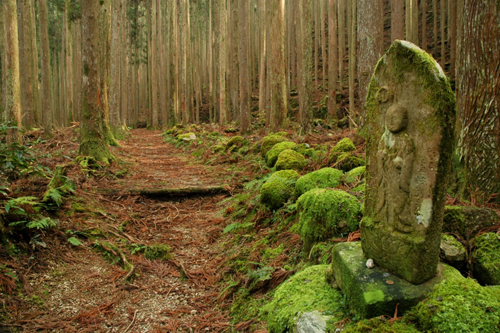We
spent some time in the realm of Japanese horror for our third week. I
read Kwaidan, a collection of short
stories and I watched Audition; a
film by Takashi Miike. Both media share similarities in the way the tales are
constructed, even if they do depart somewhat from each other in terms of
endings.
As
I was reading Kwaidan it occurred to
me how much like campfire ghost stories each tale was. Most of the stories
within Kwaidan dealt with the
supernatural in terms of vengeful or restless spirits. This is no real surprise
considering Japan’s deep spiritual beliefs about nature and the afterlife. A
vast majority of Japanese practice the Shinto religion which centers on the
connection between the past and present through the appeasement of kami, or
gods and spirits. The Japanese also have a deep respect for nature and have
designated several spots throughout Japan as places of power. In particular,
mountains have always been seen as the realm of the dead and are often
considered holy or sacred. I think it’s important to keep these traditions in
mind when analyzing Japanese horror as nearly all of its writings, horror or
otherwise, have been influenced by its spiritual beliefs.

The
Japanese belief in spirits is not just limited to those helpful kami, but also
revolves around the Oni. They are depicted as demons, devils, ogres or trolls
that seek to destroy or disrupt the individual, especially when that person has
done something dishonorable or deserving of punishment. This belief provides a
well of material for any Japanese horror writer as the figure of the demon has
been present in Japanese art and literature throughout its history.

This
style of writing also coincides with the Western tradition of story-telling
that often sees the evil-doer getting his or her comeuppance in the end. It is this similarity that led to me to
associate the stories in Kwaidan to
our own Western campfire ghost stories. However, I feel that there are still
significant differences between the two formats in the way the stories resolve.
In a lot of Western folktales, the story ends upon the discovery of the
supernatural source, ending the tale very shortly after the climax (i.e. …and
they were never seen again). With a lot of the Japanese writings, it felt like
the story continued for several more beats after the climax or discovery of the
source of the supernatural. This made the story feel stale or slow by comparison
and reduced its impact on me. Indeed, a lot of the stories had very slow parts
where nothing much happened until suddenly the vengeful spirit appears and is
just as quickly gone. Overall, I found the stories to be unrefined and lacking
any real strength in terms of their ability to frighten me. I also failed to
recognize any obvious moral to most of the stories as it was rarely the main
character that had to learn anything. Typically the main character runs across
another who had either been cursed or was an Oni in disguise. They either
dispatch or aid the other character, depending on their nature. The main
character either dies or goes on his way to tell his tale to others. There was
so little variation in structure from story to story that reading them in
procession was a bit of a task. I also
found that the image of the evil spirit has varied little throughout Japanese
history. What scared them hundreds of years ago continues to provide a source
of fear today. Note the similarities in the images below.


As
for the movie, Audition, I found
myself forgetting that I was watching a horror film; so little was the actual
horror component. It felt more like a romantic movie until the very end where
it turned into a gore-fest that was shocking only in its depiction of violence.
I was further distracted by the director’s usage of flashbacks that were not
actually flashbacks but some warped reality that the main character was
experiencing. It seemed disjointed and took me out of the film rather than pull
me in further. Overall, I didn’t find that the main character deserved his
fate. I also didn’t feel that there was a moral to the story other than “there
are crazy women out there that want to cut your feet off so beware of who you
date.”
In
summary, I don’t find anything compelling or frightening about Japanese horror
and without a convincing reason to try it again I will likely abstain from it
in the future.


.jpg)



